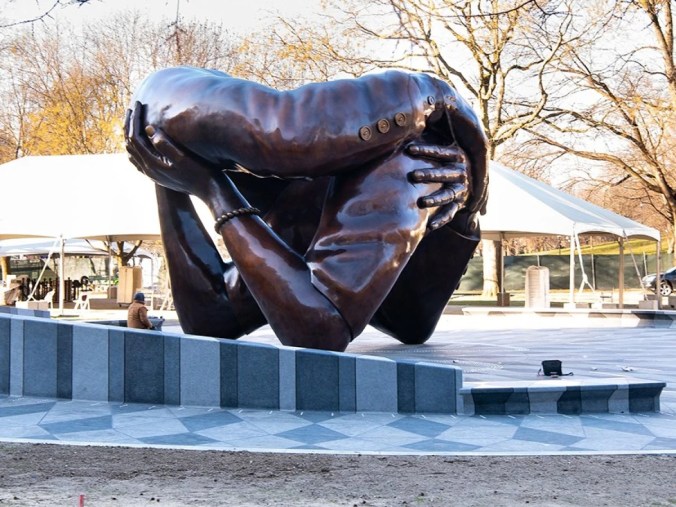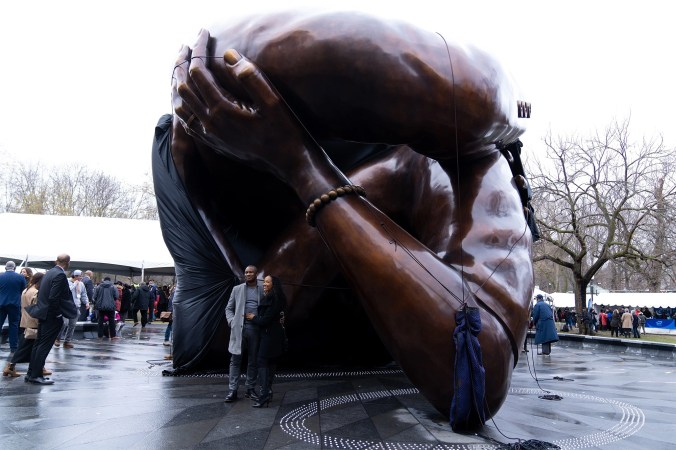Guess what American icon this newly unveiled, giant sculpture on the Boston Common memorializes? Here are several angles…
Of course, it’s Dr. Martin Luther King! Didn’t you recognize him? Titled “The Embrace,” the artwork, which cost an estimated $10 million dollars, is supposed to represent King and his wife hugging each other in Boston when he learned of his Nobel Peace Prize in 1964.
Many seem to think the thing is not only an eyesore, but an arguably pornographic one. I know, I know, most public art is controversial, but that doesn’t mean, or shouldn’t, that anything goes. Who approved that? There are no better ways to spend ten million bucks? If an artwork is supposed to honor a person or an event, is it too much to ask that someone of reasonable intelligence should be able to discern what the hell a sculpture means without an explanation?
One virtue of the MLK memorial is that it makes the pretty awful one on the Washington Mall—
— seem like a Michelangelo by comparison.
In 2020, Boston removed its “Emancipation” sculpture, the Freedman’s Memorial
…which had been on display since 1879. It was considered by some to be politically incorrect, with the symbolic image of Abraham Lincoln freeing a kneeling former slave from his chains made some residents and visitors “uncomfortable,” 12,000 people signed a petition demanding the statue’s removal. So down it went.
I bet Boston can find at least 12,000 people who are made uncomfortable by “The Embrace.” Personally, it reminds me of the sandworms in “Beetlejuice.”






I was just told it had to be shipped in, in several p pieces. Obviously a piece was missing in transit.
The moral is that you just can’t get a head in America these days.
I see what you did there…
Reminds me of the “Marie’s Sculpture” episode from Everybody Loves Raymond:
The artist appears to have been intent on proving you actually can polish something.
That monstrosity is a test. Watch to see who praises it, and who has the stones to call it out as the visual blight that it is. The latter group will of course be branded as racist, etc. This is an “Emperor’s New Clothes” situation. They’re challenging you to see how much absurdity you’ll accept and keep your mouth shut.
Some have said this “artwork” appears to be of a man attempting to stick his head up his ass.
Given its absence, maybe he succeeded?
this really did occur to me as well. (And I should know…)
I wonder whether it could have worked if it were about one-eighth as large as it is. If it were on a plinth and not on such a monumental scale, it might have worked as a sculpture. But even at a proper scale, it’s just incoherent as a monument tied to a historical event and figure.
It’s so large it’s inappropriately reminiscent of the Chicago Bean (which actually works).
Couldn’t someone have done a representational, full figure sculpture of the two of them as they appear in the photo? Sure, artistically it might have been considered mundane, but it would have memorialized the moment. I see a sculpture in the South Side of Chicago of the Obamas celebrating his Nobel Peace Prize in our future.
I suspect you’ve hit on what happened. The original sculpture would have been a smaller test, that probably worked because you can take in more of it from different angles and form an easier mental model of the whole thing.
Then they scaled it up 10x and, well, without being given the context that it’s supposed to symbolize a hug, it looks like an enormous reminder to pick up after your dog.
Yeah, sort of.
I’ll grant that it would make more sense to me to have a more representational piece whose import is more readily apparent. Nor is “The Embrace” to my tasre. Fine. But others like it, or at least purport to do so. Art engenders reactions; the fact that not all are positive does not negate those that are.
Maupassant and Zola were among those who proclaimed the Eiffel Tower an eyesore; the “Chicago Picasso” was initially described by the Chicago Tribune as a “predatory grasshopper.” Anyone who, like Curmie, has tried to study in the Reserve Room of Baker Library at Dartmouth College would very much prefer the Orozco murals to be at least somewhere else.
Moreover, the funding appears to have come from a private foundation which can spend its money how it chooses within pretty broad parameters. I do confess myself amused at the descriptions of how the piece represents the love between one of the 20th century’s most famous serial adulterers and his wife, but even that is plausible, even if eyebrow-raising.
I’m in the Live and Let Live school on this one.
There is live and let live, and there is blighting our public spaces for generations to come. The Effiel Tower was meant to be temporary, so if everyone thought it was hideous, it would have been taken down after the fair. People liked it, so it stayed. The public is stuck with this bonze heep.
Curious as to how your feelings about art change if the art is more propaganda than true art.
If art is created for a very politically relevant purpose, can you really judge whether it’s being received based on its artistic merit? And does that matter?
Propaganda and “true art” overlap, or we wouldn’t have the Sistine Chapel, Macbeth, or the Brandenburg Concertos. I certainly don’t think, a la “Socialist realism,” that an artwork ought to be based solely on its service to a political cause. But we must recognize that para-aesthetically our reaction to an artwork is going to be partially influenced by what we think of the politics of the piece.
“Fairness” isn’t really possible–you can’t do a version of Henry V that’s “fair” to the French. What we can do is recognize that Sergei Eisenstein and Leni Reifenstahl were good at their jobs, while simultaneously rejecting the propagandistic qualities of their work.
With something like this piece, though, I think that’s less relevant. Few people today would regard MLK as unworthy of recognition (the extent of that recognition, perhaps, but not its existence. But I don’t think there are a lot of folks who would argue that literally any invocation of Dr. King is inherently an artistic success. The sculpture stands or falls on its own merits, or rather on the public’s perception of those merits. Some people tell us to like it, others to hate it. Ultimately, we decide independently.
Art is subjective. As you know.
Certain angles are odd, some nice.
Some look like someone carrying a huge turd.
Infinite possibilities for interpretation.
Would never have made me think of him though.
All good art opens up several discussions about several topics- even opens up multiple discussions of interpretation.
But at a bare minimum one of those topics has to be quite obviously what the piece of art actually clearly is.
That’s lacking here. Most of the discussions are desperately and emphatically compelled to discuss what this sculpture is not.
Comment eaten. Grrrr no clue why
It came back on its own, no?
I know this is a little off topic of the email I am replying to, but I would like to point out the ethics gap of our congress increasing their own salaries while removing the part of the December legislation that would have allowed SSI recipients to increase their savings to $10,000 instead of the parsimonious $2,000 it has been since 1989. It is not like their benefits would increase. It would be allowing them to put aside enough of their existing income in a savings account to weather home repairs, saving up a deposit for the need to move into different rental housing, the means to repair or replace an older used car and many other non-luxury expenditures that are currently out of reach for SSI recipients.
Kathy J.
It’s something that’s been true for government handouts for as long as I can remember. Once you accept a handout from the government, it will be nearly impossible for you to get out whatever circumstances led you to need that handout, so you’ll be needing that handout in perpetuity, requiring you to settle into poverty and never try to get out of it.
The $2k cap should be pegged to inflation.